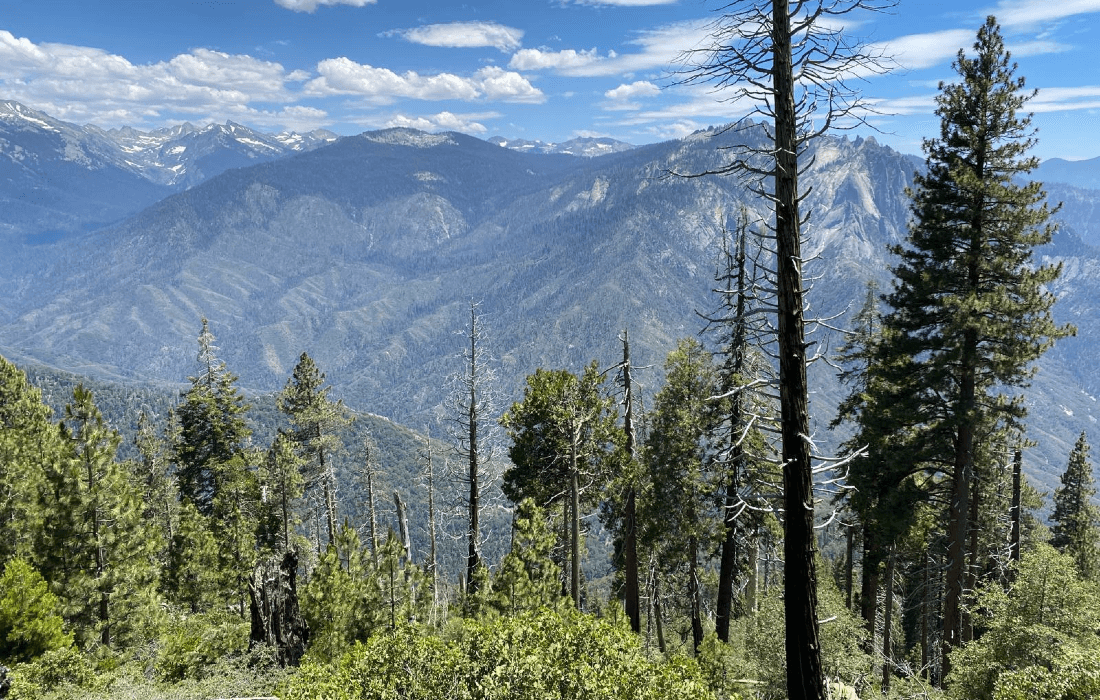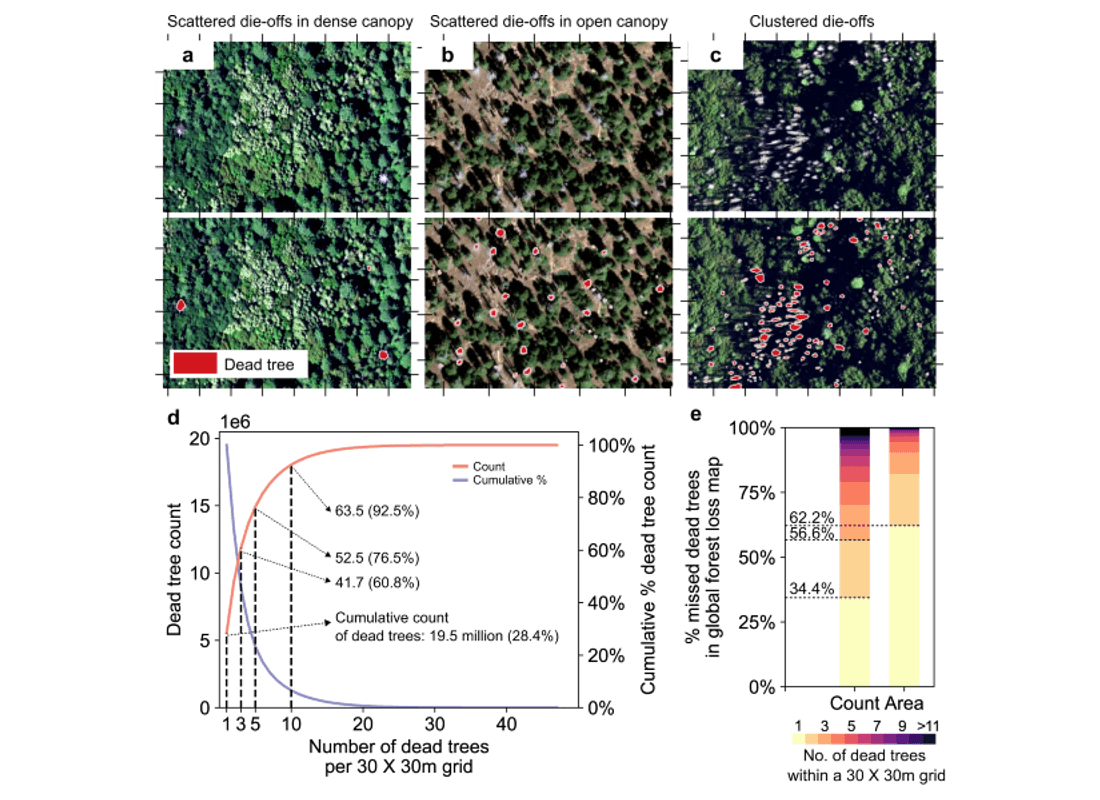AI method reveals millions of dead trees hidden among the living before California’s historic 2020 wildfires
University of Copenhagen scientists may have found a new explanation for the California wildfires of 2020. Applying AI to detailed aerial photos, they created a unique dataset detailing mortality down to single trees for all of California State. This revealed individual and clustered tree death spread out among the living on a large scale. The new AI-model will increase understanding of tree mortality and give us a chance to prevent droughts, beetles and flames from destroying the world’s forests.

For better or worse, climate change has thrust forests into the global limelight. Initiatives to plant trees and increase forest area have sprung up worldwide because trees can extract and store atmospheric CO2. At the same time, massive and more frequent wildfires have raged and forced hundreds of thousands of people from their homes.
California has been one of the places hit hardest by droughts and wildfires, and saw 4% of its landmass go up in smoke in 2020. Now, scientists at the University of Copenhagen present a new picture of the health of Californian forests, revealing a new account of dead trees in the region, and possibly a new underlying explanation for the extensive fires in a study published in Nature Communications.
Leveraging an optimized AI model applied to aerial photos with sub-meter resolution the researchers were able to extensively map tree health across the entire Californian State, detailing the spread of dead trees (over 90 million trees) with a precision never achieved before. Importantly the feat revealed an undercount of dead trees all sharing a special characteristic:
"Our data show that a vast amount of these trees are isolated or located in small clusters of only a few trees, which has allowed them to hide scattered amidst healthy, living trees from coarse-resolution satellite images. This is new knowledge," says Stéphanie Horion from the University of Copenhagen’s Department of Geosciences and Natural Resource Management.
According to the researcher, fire spread during wildfires is strongly related to the uneven distribution of fuel in both density and flammability.
“This makes it reasonable to speculate that such scattered enclaves of dead dry trees could have acted as kindling between living trees, affecting the intensity and spreading of the wildfires. This new knowledge is interesting both as a possible part of the explanation for California’s violent wildfires, but also very much for our attempts at understanding the phenomenon of tree death more generally,” says Stéphanie Horion.
Extra info: California wildfires
According to US agencies, 2020 was the largest wildfire season in California's modern history. The state was plagued by record-breaking wildfires that, by the end of the year, had wiped out nearly 17,000 square kilometers of forest in roughly 10,000 fires. This burned area accounts for more than 4% - over 400,000 square kilometers - of the state. One of these wildfires, the so-called August Complex fire that occurred in Northern California’s Coast Range, has been described as the world’s first "gigafire" – a massive wildfire that scorched more than one million acres (4,047 square kilometers).
Among the triggers were intense thunderstorms with many lightning strikes and a combination of record heat and heavy winds. However, climate change is the major underlying driver. It increases the likelihood of such fires, and their intensity, not least due to more frequent and persistent droughts that lower the resilience of trees and lead to tree death.

Fire isn’t the biggest tree killer
In fact understanding fire was not the intention of the study. Rather than studying forest fires in and of themselves, the researchers sought to understand the global phenomenon of massive tree death, whereby large areas of forest suddenly die out. The phenomenon has become increasingly frequent and is driven by climate change.
Due to the impressive and threatening nature of wildfires, in the public eye they are often erroneously viewed as the singular greatest cause of tree death. The California case study shows this is not the case. In fact it turns out to be the other way around.
"The new data shows that drought and subsequent insect attacks are the biggest killers in forests. Fire can follow as an indirect consequence. For a wildfire to erupt, three basic elements are necessary: hot, dry weather and climatic conditions that climate change has increased the frequency of, an ignition source – such as a lightning strike or careless human – and finally, an abundance of combustible materials. Drought weakens “the immune systems” of trees, which increases the risk of tree mortality in the wake of bark beetle attacks. And dead trees burn well," explains Stéphanie Horion.
She points to the Harz Forest in Germany as an example of massive forest death, where drought and then bark beetles killed huge swaths well before any wildfire.
"Ironically, many locals were delighted when bark beetles were first discovered there, as it was considered as a sign of forest health and biodiversity. Since then, it has been shown that these beetles spread like an epidemic during times of drought, and that a third of the trees in the Harz Forest have now died as a result. We need to learn from this if tree planting is to play an important role as a climate solution," says the researcher.
She underscores that the new AI model could become a vital tool in the future, as the effective mapping of tree deaths can provide researchers and public agencies with an early warning system that makes it possible to intervene in time.
Extra info: Harz in crisis
The Harz National Park in Northern Germany is a roughly 250 km2 large mountain forest – perhaps most well known for Brocken mountain. The area has long been favoured as a tourist destination for its forested hiking trails, among other things.
In the past five years however, the forest has been the scene of one of the most extensive cases of massive tree death. As a result of drought and the subsequent weakening of tree immune systems, coupled with the invasion of tree bark beetles, large areas of the forest now stand as a wasteland of dead trees.
When first discovered, the bark beetle was received with joy in many places, as people saw its arrival as a sign of increased biodiversity in the national park. A mascot of the beetle was even created.
Unfortunately, the beetle has cost the Harz about 30% of its forested area since 2019 in a mass death that extends for more than 100 km2.
AI monitoring of tree death has global potential and importance
To develop the new method, first author of the study, Yan Cheng trained an AI-model to examine detailed aerial photos and recognize signs of tree death. To achieve this, Yan, who is a PhD student on the DRYTIP project that investigates drought-induced ecosystem tipping points, used more than 20.000 computer-friendly polygons to define areas with specific characteristics.
Polygons are a way of dividing an area into clearly defined parts suitable for AI learning, and where used to train the AI to recognize trees in varying conditions and distinguish dead from alive (i.e. varying landscapes and varying stages of dying).

Put very simply, the approach makes it possible to distinguish between living forests, dead forests and forests with a mixture of dead and living trees.
The result was significant in the subsequent case study to test the model, which consisted of a large number of high-quality aerial photos of California forests.
"The model performs way beyond expectations. Of the 90 million dead trees that our artificial intelligence identified, about 60% would have remained unseen using the current state-of-the-art method of mapping forest disturbances (i.e. damages to forest health)," Yan Cheng explains.
The problem of climate-induced tree death, however, is far from local. Fortunately, the method has also proved useful in other parts of the world, and the researchers are now conducting similar studies in more places around the world.
"Since California, we’ve tested it in other places. And, even without calibrating the model for other forest types, it has provided surprisingly accurate results. Once calibrated for local conditions, with regards to local tree types and terrain, it will be even more effective," says Cheng.
The researchers hope their algorithm can become an important global tool. In support of this aim, both their results and the code are freely available to researchers and public agencies.
About the research:
DRYTIP project
The study is a part of DRYTIP - Drought-Induced Tipping Points in Ecosystem Functioning, funded by Villum Fonden (2021-2026), that explores large-scale vegetation mortality as a result of extreme droughts.
DRYTIP relies on global Earth Observation (EO) data for vital insights into earth’s ecosystems. Combining field ecology, dynamic vegetation models, and EO data, it seeks to uncover new knowledge on ecosystem resilience to climate extremes.
Part of the Dead trees initiative
The researchers are also actively contributing to the deadtrees.earth initiative:
An open database gathering remotely sensed information (for example, drones and aerial imagery) on tree death.
The new AI model is thought to become one of the key models supported on the new platform, allowing users across the globe to apply it over their own area.
Behind the research:
The following scientists contributed to the research:
Yan Cheng, Martin Brandt, Maurice Mugabowindekwe, Wim Verbruggen, Claus Beier & Stéphanie Horion
- Department of Geosciences and Natural Resource Management, University of Copenhagen, Copenhagen, Denmark.
Stefan Oehmcke
- Department of Computer Science, University of Copenhagen, Copenhagen, Denmark.
Lisa Rosenthal & Adrian Das
- US Geological Survey, Western Ecological Research Center, Three Rivers, Sequoia and Kings Canyon Field Station, Three Rivers, CA, USA.
Anton Vrieling
- Faculty of Geo-Information Science and Earth Observation (ITC), University of Twente, Enschede, The Netherlands.
Sassan Saatchi & Fabien Wagner
- University of California, Los Angeles, CA, USA
- Jet Propulsion Laboratory, California Institute of Technology, Pasadena, CA, USA
Contact
Stéphanie Horion
Associate Professor
Department of Geosciences and Natural Resource Management
University of Copenhagen
smh@ign.ku.dk
+45 3532 5878
Yan Cheng
Ph.D. Student
Department of Geosciences and Natural Resource Management
University of Copenhagen
yach@ign.ku.dk
Phone: +45 3532 2350
Kristian Bjørn-Hansen
Journalist and Press Contact
Faculty of Science
University of Copenhagen
kbh@science.ku.dk
+45 93 51 60 02
